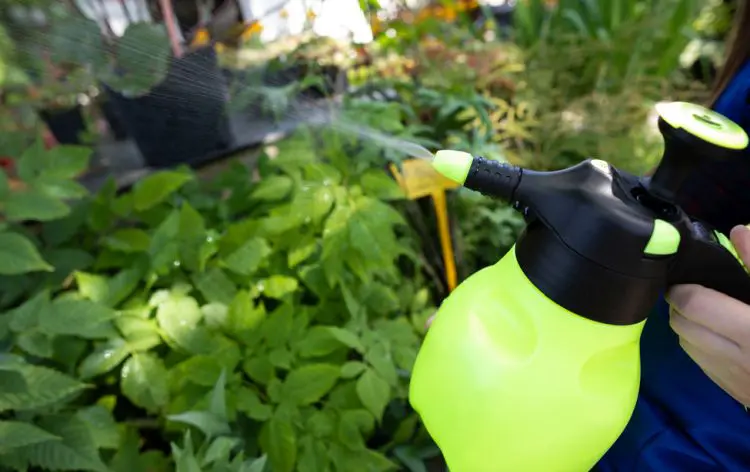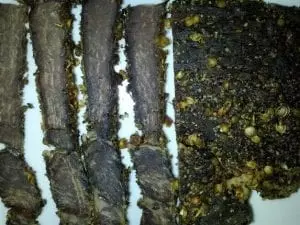Walk into any garden store or nursery, and you’ll find literally hundreds of products to spend money on. From fertilisers to weedkiller, pest deterrents to lawn stimulants, they’ve got it all. But did you know that you can make some of those products at home at a far lower cost? Not only that, but they’re quick to make and won’t contain any nasty chemicals. I’ve rounded up recipes for 5 of the best, easiest and most useful DIY organic garden sprays that really work.

Why Do We Need to Use Sprays?
Pest control and fertilising are the most common reasons to use sprays in the garden. All soil needs added nutrition, and every vegetable gardener has pest trouble from time to time. Pests in the garden often indicate some sort of imbalance. It might be that we haven’t done something that we should have, or perhaps have over-done something. Things like giving too much nitrogen, too much water, not enough water or not enough fertiliser can all lead to pest problems. For example, aphids will be attracted to the abundance of soft new growth that comes from too much nitrogen.
Cheap and easy options are always attractive, but finding low-toxic alternatives to chemicals is of increasing importance as organic gardening and sustainable lifestyles are becoming more mainstream. Organic sprays are part of a holistic approach to garden management. They are easy to make and use, but do need to be reapplied regularly as most will wash off when it rains.
Garlic Spray
A simple spray made from garlic, oil, soap and water works against caterpillars and soft-bodied insects. Garlic is a repellant, so you need to apply this remedy before any pest activity occurs. Your experience might tell you that certain plants attract a specific pest (fennel with aphids, for example), so be sure to apply this spray when the plants are still small.
- 3 large cloves freshly crushed garlic (minced garlic in a jar is fine too)
- 1 tablespoon of vegetable oil
- 1 teaspoon of liquid soap
- 1 litre of water (1 quart)

Combine the garlic and vegetable oil and leave to soak overnight. Strain and add to the litre of water along with the liquid soap. Spray regularly and reapply after rain. Use this mixture at it’s freshest, as that is when it is most potent.
If a garlic spray isn’t doing the job for you, perhaps try a chilli spray, which is a bit stronger. Alternatively, garlic and chilli sprays can be combined for an extra potency.
Chilli Spray
To insects, chilli is a general irritant. If insects consume chilli, it is a stomach poison. You can use chillies that you’ve grown yourself, dried chillies that you’ve bought, or in a pinch, a bottled hot chilli sauce.

- 20+ small hot chillies
- 2 litres of water (2 quarts)
- 1 teaspoon liquid soap or 5 grams of pure soap flakes dissolved in hot water
- Puree the chillies and one litre of water together in a blender. Strain the mixture through a fine sieve and add the soap and the other litre of water. Spray this mixture undiluted on to plants.
Like the garlic spray, chilli spray is stronger when fresh, & works on soft-bodied insects like ants, aphids and caterpillars. Be sure to wear gloves when mixing and spraying this one, & keep it out of reach of children.
‘White Oil’ Spray
White oil is used to combat sap-sucking and chewing insects like aphids, scale, mealy bug and citrus leaf miner. It suffocates them rather than poisons them, so they can’t develop a resistance to it. Spray it on both sides of all leaves and stems so that it works properly. Oil-based sprays such as white oil are usually stronger than soap sprays. This is because oil acts to smother insects, while soap is a dessicant. Like all home-made sprays, this is most effective when fresh and needs reapplying after rain.

- 2 cups cooking oil
- 1 cup dishwashing liquid
- 1 litre water (1 quart)
Mix the oil and dishwashing liquid together in a bottle. Dissolve one tablespoon of this mixture in a litre of water, then spray liberally on plants.
Molasses Spray
This is a simple concoction of molasses, soap and water which prevents caterpillars eating everything in your garden. It also acts against soil-borne pests like cutworm and nematodes. Black strap is the best type of molasses to buy because it is the most concentrated. Shop around if you can- produce stores will often be cheaper than the supermarket for this product.

- 1 tablespoon black strap molasses
- 1 teaspoon liquid soap
- 1 litre water (1 quart)
Mix all three ingredients together and apply as a foliar spray to affected plants. If soil-borne pests are your problem, molasses spray can be used as a soil drench. When sprayed on the soil as a drench it will act against nematodes, lily caterpillars, cutworm and beetle larvae. Be sure to use molasses spray within a couple of days, as it will ferment and can expand your container.
Liquid Fertiliser
Home-made liquid fertilisers can give a much-needed boost to your quickly growing edibles. They are more gentle but faster-acting than solid fertilisers, so are ideal to use during the growing season. There are lots of things you can make liquid fertiliser from, including weeds, manure, compost, seaweed, banana peel and epsom salts.

You probably have one or more of these sitting around at home that you can use for free. (Seriously, who doesn’t have a few weeds to pull out?). In a nutshell, all you need to do is soak your solid material in a bucket of water for a week or two until it breaks down. You then dilute the solution in water (at about a 10:1 ratio) then apply to plants.
Fertiliser is created because the water slowly absorbs nutrients from your chosen material during the soaking. These nutrients will be readily taken up by a plants root system because they are in a soluble form. Liquid fertiliser can be applied directly to the soil around a plant or sprayed on to the foliage. You can use it on seedlings too, as long as the solution is very weak.
DIY garden sprays are organic & cheap to make, and are another great step to take in your self-sufficient journey. Give them a try and let us know how you go!













